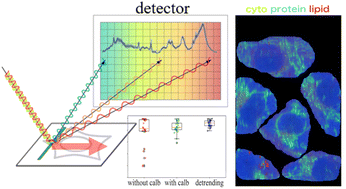Differentiability of cell types enhanced by detrending a non-homogeneous pattern in a line-illumination Raman microscope†
Abstract
A line illumination Raman microscope extracts the underlying spatial and spectral information of a sample, typically a few hundred times faster than raster scanning. This makes it possible to measure a wide range of biological samples such as cells and tissues – that only allow modest intensity illumination to prevent potential damage – within feasible time frame. However, a non-uniform intensity distribution of laser line illumination may induce some artifacts in the data and lower the accuracy of machine learning models trained to predict sample class membership. Here, using cancerous and normal human thyroid follicular epithelial cell lines, FTC-133 and Nthy-ori 3-1 lines, whose Raman spectral difference is not so large, we show that the standard pre-processing of spectral analyses widely used for raster scanning microscopes introduced some artifacts. To address this issue, we proposed a detrending scheme based on random forest regression, a nonparametric model-free machine learning algorithm, combined with a position-dependent wavenumber calibration scheme along the illumination line. It was shown that the detrending scheme minimizes the artifactual biases arising from non-uniform laser sources and significantly enhances the differentiability of the sample states, i.e., cancerous or normal epithelial cells, compared to the standard pre-processing scheme.



 Please wait while we load your content...
Please wait while we load your content...